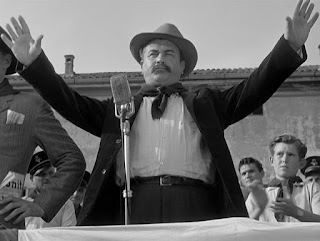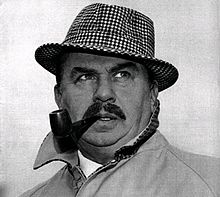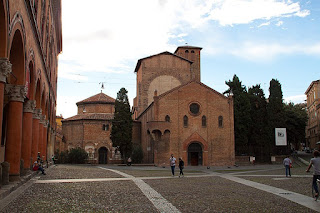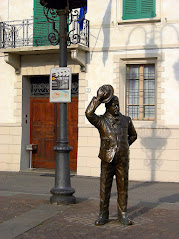NEW - Gino Cervi - actor
Star best known for Don Camillo and Maigret
The actor Gino Cervi, a star of cinema and television screens in Italy for more than four decades as well as an accomplished stage performer, was born on this day in 1901 in Bologna. Although his movie credits run to more than 120, he is probably best known for his portrayal of the Communist mayor Peppone in the Don Camillo films of the 1950s and ‘60s, and for playing Chief Inspector Maigret in the Italian TV series of the ‘60s and ‘70s based on the crime novels of Georges Simenon. Cervi was the father of Italian film producer Tonino Cervi and the grandfather of actress Valentina Cervi. Born Luigi Cervi in the historic Santo Stefano district of Bologna, Gino’s interest in acting had its roots in his journalist father Antonio’s appointment as theatre critic for Il Resto del Carlino, the city’s daily newspaper. As a boy, he persuaded his father to take him to the theatre, soon developing an ambition to be a stage actor, which is where his talents first became known. After his stage debut in 1924 - sadly, too late to be witnessed by his father, who died in 1923 - Cervi was invited the following year to join the company of the Teatro d’Arte di Roma. Read more…
_______________________________________
Philosopher and polymath with a playboy lifestyle
The multi-talented writer, philosopher and art connoisseur Francesco Algarotti, one of the most prominent and colourful individuals in 18th century intellectual society, died on this day in 1764 in Pisa. Algarotti, who wrote many essays and a number of books, was something of a polymath in his breadth of knowledge on a wide number of subjects, including architecture and music as well as art. He was also a charismatic figure who became friends with most of the leading authors of his day, including Voltaire, Jean-Baptiste de Boyer, Marquis d'Argens and Pierre-Louis de Maupertuis. His urbane manner and suave good looks, combined with his considerable intellect, led him to acquire admirers of both sexes. Indeed, at one time he is said to have found himself at the centre of a colourful bisexual love triangle involving John Hervey, the English peer and politician, and Lady Mary Wortley Montagu, the aristocratic travel writer, who became infatuated with Algarotti at the same time as Hervey, her one-time lover. Algarotti was often engaged by the courts of European monarchs to acquire or commission paintings. Read more…
_____________________________________
Niccolò Machiavelli – writer and diplomat
Political scientist fathered belief that ‘the ends justify the means’
Statesman and diplomat Niccolò Machiavelli, whose name has become synonymous with the idea of political cunning, was born on this day in 1469 in Florence. The ideas he put forward in his writing were to make the word ‘machiavellian’ a regularly used pejorative adjective and the phrase ‘Old Nick’ a term to denote the devil in English. The son of an attorney, Machiavelli was educated in grammar, rhetoric and Latin. After Florence expelled the Medici family in 1494 he went to work for the new republic in the office that produced official Florentine documents. Machiavelli also carried out diplomatic missions to Rome on behalf of the republic where he witnessed the brutality of Cesare Borgia and his father, Pope Alexander VI, as they tried to acquire large parts of central Italy. He later became responsible for the Florentine militia and, because of his distrust of mercenaries, used citizens in the army. Under his command, Florentine soldiers defeated Pisa in battle in 1509. But Machiavelli’s success did not last and in 1512 the Medici, using Spanish troops, defeated the Florentines at Prato. He was dismissed from office in Florence by a written decree issued by the new Medici rulers. Read more…
____________________________________
Battle of Tolentino
Murat is defeated but ignites desire for Risorgimento
Neapolitan troops were defeated by Austrian forces on this day in 1815 near Tolentino in what is now the Marche region of Italy. It was the decisive battle in the Neapolitan War fought by the Napoleonic King of Naples, Joachim Murat, in a bid to keep the throne after the Congress of Vienna had ruled that the Bourbon Ferdinand IV, King of Sicily, should be restored. The conflict was similar to the Battle of Waterloo, in that it occurred during the 100 days following Napoleon’s return from exile. Murat had declared war on Austria in March 1815 after learning about Napoleon’s return to France and he advanced north with about 50,000 troops, establishing his headquarters at Ancona. By the end of March, Murat’s army had arrived in Rimini, where he incited all Italian nationalists to go to war with him against the Austrians. But his attempts to cross the River Po into Austrian-dominated northern Italy were unsuccessful and the Neapolitan army suffered heavy casualties. The United Kingdom then declared war on Murat and sent a fleet to Italy. Murat retreated to Ancona to regroup his forces, with two Austrian armies pursuing him. Read more…
_____________________________________
Raffaele Riario – Cardinal
Patron of arts linked with murder conspiracies
Renaissance Cardinal Raffaele Riario was born Raffaele Sansoni Galeoti Riario on this day in 1461 in Savona. A patron of the arts, he is remembered for inviting Michelangelo to Rome and commissioning Palazzo della Cancelleria to be built. He was also embroiled in murder conspiracies which nearly cost him his life. Although Riario was born in poverty, his mother was a niece of Francesco della Rovere, who became Pope Sixtus IV in 1471. As a relative of the Pope he was created a Cardinal in 1477 and was named administrator of several dioceses, which gave him a good income at the age of 16, while he was studying canon law at the University of Pisa. On his way to Rome in 1478, Riario stopped off in Florence, where he became a witness to the Pazzi conspiracy against the Medici. The Pazzi family wanted to replace the Medici as rulers of Florence. They attempted to assassinate Lorenzo, who was wounded but survived, and his brother Giuliano, who was killed, while they were attending mass in the Duomo. The conspirators were caught and executed and Riario was also arrested because he was related to Girolamo Riario, his uncle, who was one of the masterminds behind the plot. Read more…



















.jpg)



.jpg)


.jpg)



.jpg)